WhatsApp Product Catalog Best Practices for Shopify Stores in 2025
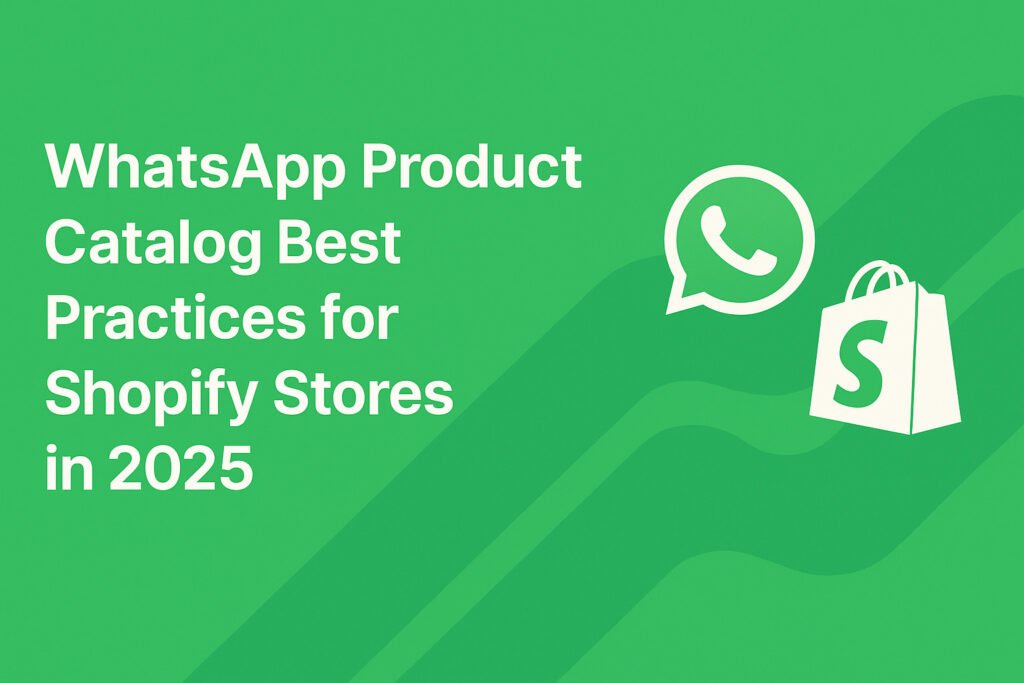
Introduction In 2025, WhatsApp has emerged as a vital growth channel for D2C eCommerce brands—especially those powered by Shopify. With exceptionally high engagement rates and real-time customer interactions, integrating your product catalog with WhatsApp is no longer a nice-to-have; it’s a necessity. This blog outlines the best practices for building and optimizing a WhatsApp product catalog tailored to Shopify stores. The goal? To enhance product discovery, drive conversions, and deliver a seamless mobile-first shopping experience. Why WhatsApp Catalogs Matter for Shopify Sellers A WhatsApp product catalog enables your brand to showcase items directly within customer chats. Shoppers can view, inquire about, and even purchase products without ever leaving WhatsApp. For D2C brands, this results in: Best Practices to Set Up a WhatsApp Catalog for Shopify 1. Connect Shopify with a Verified WhatsApp Business API Start by verifying your WhatsApp Business account. Then integrate your Shopify product database using TheBotMode’s API connector. Key Benefits: 2. Organize Products into Smart Categories Keep your catalog easy to navigate. Group products based on shopping behavior and UX simplicity: 3. Use High-Quality Images and Descriptive Copy Make every listing count. Ensure your products are: 4. Include Clear CTAs and Direct Purchase Links Every product in your catalog should feature: 5. Enable Smart Filters and Quick Replies Improve UX with features that support quicker browsing and selection: This is especially helpful for mobile-first shoppers in India and other D2C markets. Best Timing for Sharing WhatsApp Catalogs Based on TheBotMode’s data, optimal send times for catalog campaigns are: Avoid early mornings or late nights to reduce opt-outs and avoid being marked as spam. Optimize for Local and Global Shoppers If your Shopify store serves customers across regions: Use Catalog Analytics to Improve Performance Monitor and improve your product catalog strategy by tracking: TheBotMode’s analytics dashboard provides real-time insights to help you refine catalog structure, offers, and timing. Conclusion Optimizing your WhatsApp product catalog is one of the most strategic moves for Shopify-based D2C brands in 2025. It delivers a mobile-first, frictionless, and engaging shopping experience—right where your customers are. With TheBotMode’s automation, analytics, and seamless Shopify integration, you can build a high-performance WhatsApp catalog engine that boosts visibility and drives sales around the clock. FAQs Q1: What is a WhatsApp product catalog? A WhatsApp catalog is a digital storefront embedded in WhatsApp chats that allows businesses to display products with descriptions, prices, and direct links. Q2: Can I integrate my Shopify store with WhatsApp? Yes. Using TheBotMode’s integration, you can sync products directly from your Shopify store into WhatsApp via the official Business API. Q3: How many products can I add to a WhatsApp catalog? You can list up to 500 products, but for best user experience, prioritize your top-performing categories. Q4: Can customers buy directly from WhatsApp? Yes. Each catalog item can include a direct Shopify checkout link, allowing instant transactions within chat. Q5: Is WhatsApp catalog marketing compliant in India? Yes, as long as your business follows WhatsApp’s commerce policy and messages are sent to users who have opted in.
How to Use WhatsApp for Smart Upselling in 2025
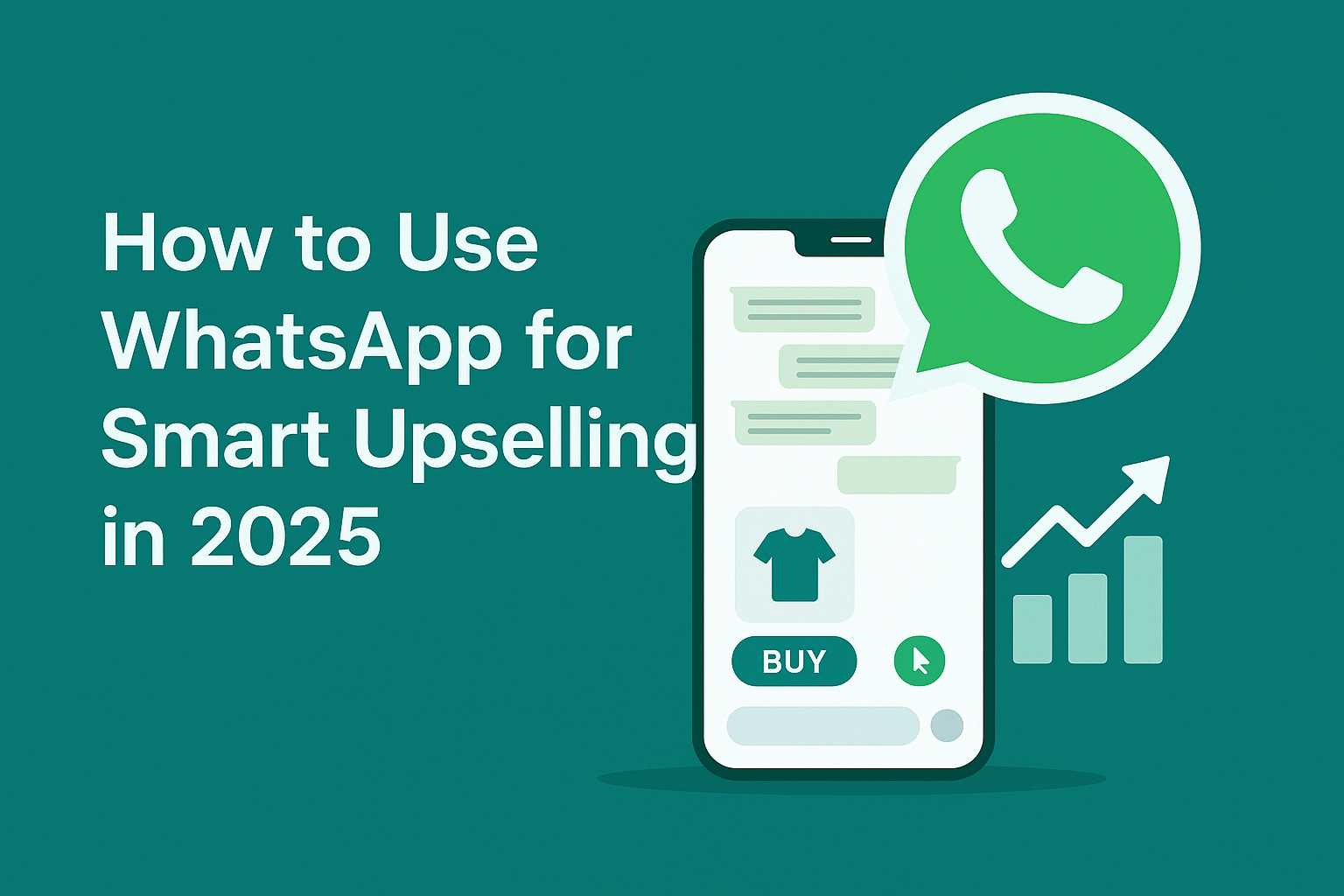
Introduction WhatsApp isn’t just for chatting—it’s become a powerhouse for conversational commerce. With over 2.5 billion+ users and up to 98 % message open rates, brands can now convert chats into sales . Yet many businesses miss the opportunity to use WhatsApp as a direct upselling channel. This blog reveals how to implement smart, personalized upsells using The Bot Mode, ensuring real growth in 2025. Why Upselling via WhatsApp Works in 2025 Key WhatsApp Features to Leverage Best Practices for Smart Upselling Upselling Scenarios & Campaign Ideas Scenario Smart Upsell Tactic Abandoned Cart Send chat reminders + suggest a premium bundle Post-Purchase Recommend complementary add-ons in the confirmation chat Order Confirmation Immediately present discounts on future upgrades Broadcast Campaigns Share curated new collections or limited-time offers Metrics to Track for ROI Track these in your Bot Mode dashboard for data-backed optimization: Tools & Integrations via The Bot Mode Step-by-Step Smart Upselling Blueprint Real-Life Case Study A direct-to-consumer brand used The Bot Mode’s API upsell flow and saw a 27 % increase in average order value, thanks to targeted post-purchase add-ons and catalog-driven messages. Conclusion & Call to Action Smart upselling on WhatsApp now means delivering personalized, well-timed offers through end-to-end automated chat flows. With The Botmode, you’re equipped to boost AOV, retention, and revenue, starting with just one upsell flow this week. 🔗 Dive deeper: WhatsApp for Upselling Guide Ready to launch? Start your WhatsApp API upsell flow today! FAQs 1. What upselling messages work best on WhatsApp? Use concise messages featuring product images, clear CTAs, and urgency tags like “Limited stock!” 2. How often should I send upsell messages? The ideal frequency is 1–2 flows per buyer session, such as cart abandonment or post-order. 3. Can The Botmode fully automate upsells? Absolutely. The platform supports full API-driven automation with fallback to human agents when needed.
WhatsApp Support for D2C Brands: Boost Engagement & Sales
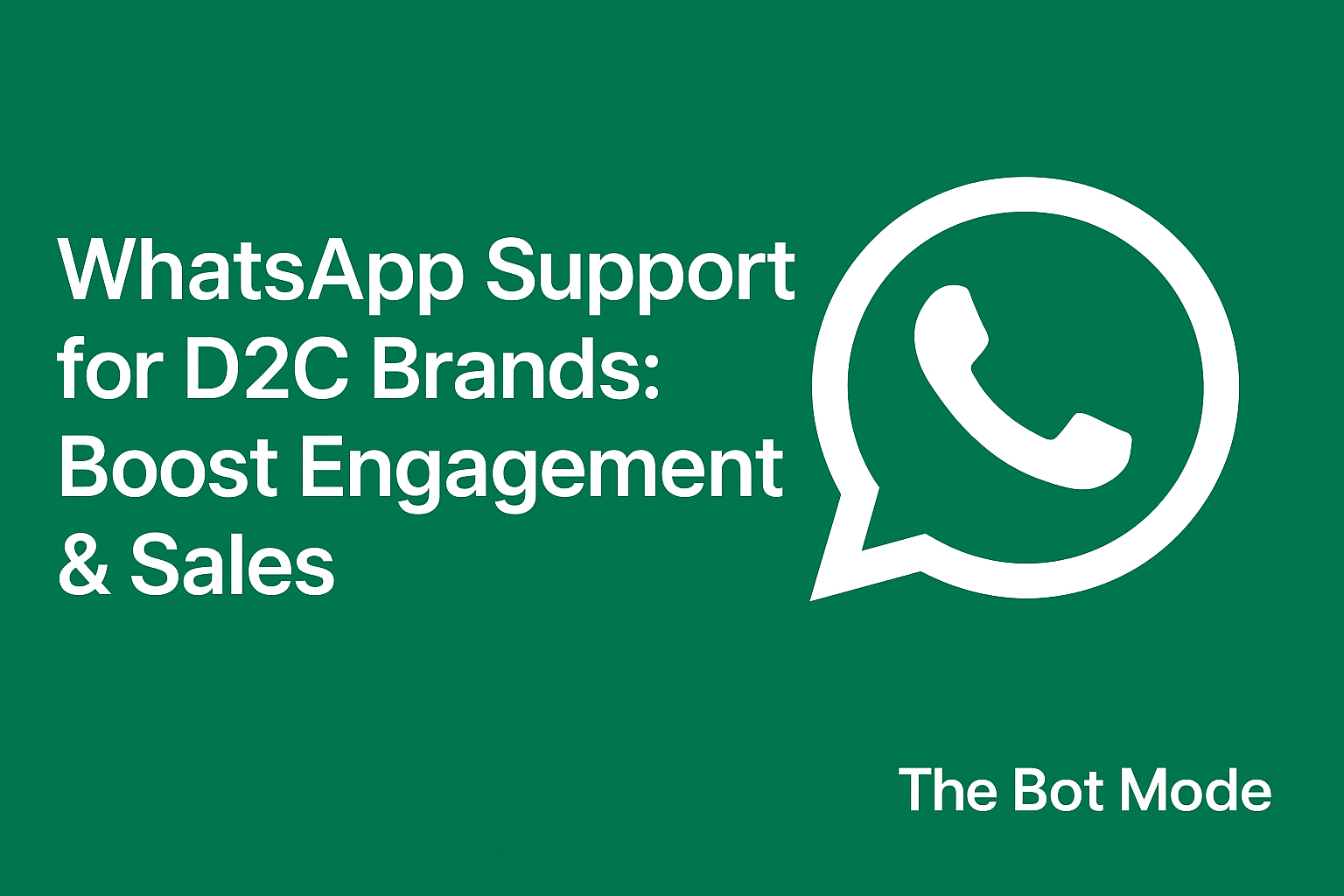
Introduction In a world where consumers crave real-time, personalized interactions, WhatsApp has emerged as a vital communication channel for D2C brands. Whether a shopper has a query, abandons their cart, or needs a loyalty nudge, conversational support converts. The Bot Mode offers intuitive, scalable WhatsApp automation that turns support into sales. Here’s how it all works. Why WhatsApp Is Essential for D2C Brands These stats highlight the unparalleled impact of WhatsApp—your best channel for visibility, engagement, and conversion. How The Bot Mode Transforms WhatsApp Into a Sales Engine Real-Time, 24/7 Customer Support The Bot Mode combines intelligent bots with seamless human-agent handoffs, ensuring instant replies—even outside office hours. This level of responsiveness fosters trust and reduces churn by handling queries swiftly and accurately. Cart Recovery & Lead Nurturing With automated workflows, The Bot Mode can trigger cart abandonment reminders—recovering up to 60% of abandoned cart. Timely, personalized nudges help guide shoppers back to checkout. Promotional Campaigns & Broadcasts Segment your audience using CRM data and broadcast tailored offers, flash-sales, and new product drops via WhatsApp. With 15–50% CTR on campaigns in regions like India and Brazil, The Bot Mode maximizes campaign ROI. Built-in Features That Maximize Support & Sales API & No‑Code Integrations Easily connect The Bot Mode with Shopify, WooCommerce, and CRMs to auto-sync product catalogs, order info, and client details. This means agents can share product cards or checkout links directly in chat—making WhatsApp a true sales channel. Powerful Automations & Workflows Design workflows with triggers, conditional paths, and messaging sequences. Automate everything—from welcome messaging to post-purchase support—without writing any code. Human-Agent Escalation Bots manage routine tasks, while complex queries seamlessly escalate to human agents. This ensures empathy, clarity, and user satisfaction—especially with tricky post-sales issues. H2: Results D2C Brands Can Expect with The Bot Mode H2: Why The Bot Mode Is the Best WhatsApp Solution for D2C Brands H2: Conclusion & Call to Action WhatsApp isn’t just a messaging app—it’s a high-converting, customer-first commerce channel. The Bot Mode amplifies this potential—boosting sales, loyalty, and engagement with smart, automated conversations.Ready to convert more with WhatsApp? Get started with The Bot Mode today! H2: FAQs 1. When can I get started with WhatsApp and The Bot Mode? You can launch automated WhatsApp support in days—no developer required. 2. Is WhatsApp automation developer-friendly? Not at all—it features no-code workflows for easy setup. 3. Is The Botmode suitable for both startups and scale-ups? Yes, our flexible plans cater to brands of all sizes. 4. What are the costs? We offer tiered plans based on messaging volume, which is suitable for growing budgets. 5. Is customer data secure and compliant? Absolutely. WhatsApp encryption and compliance with GDPR are built in.
Boost D2C Product Launches: WhatsApp Strategies That Drive Sales
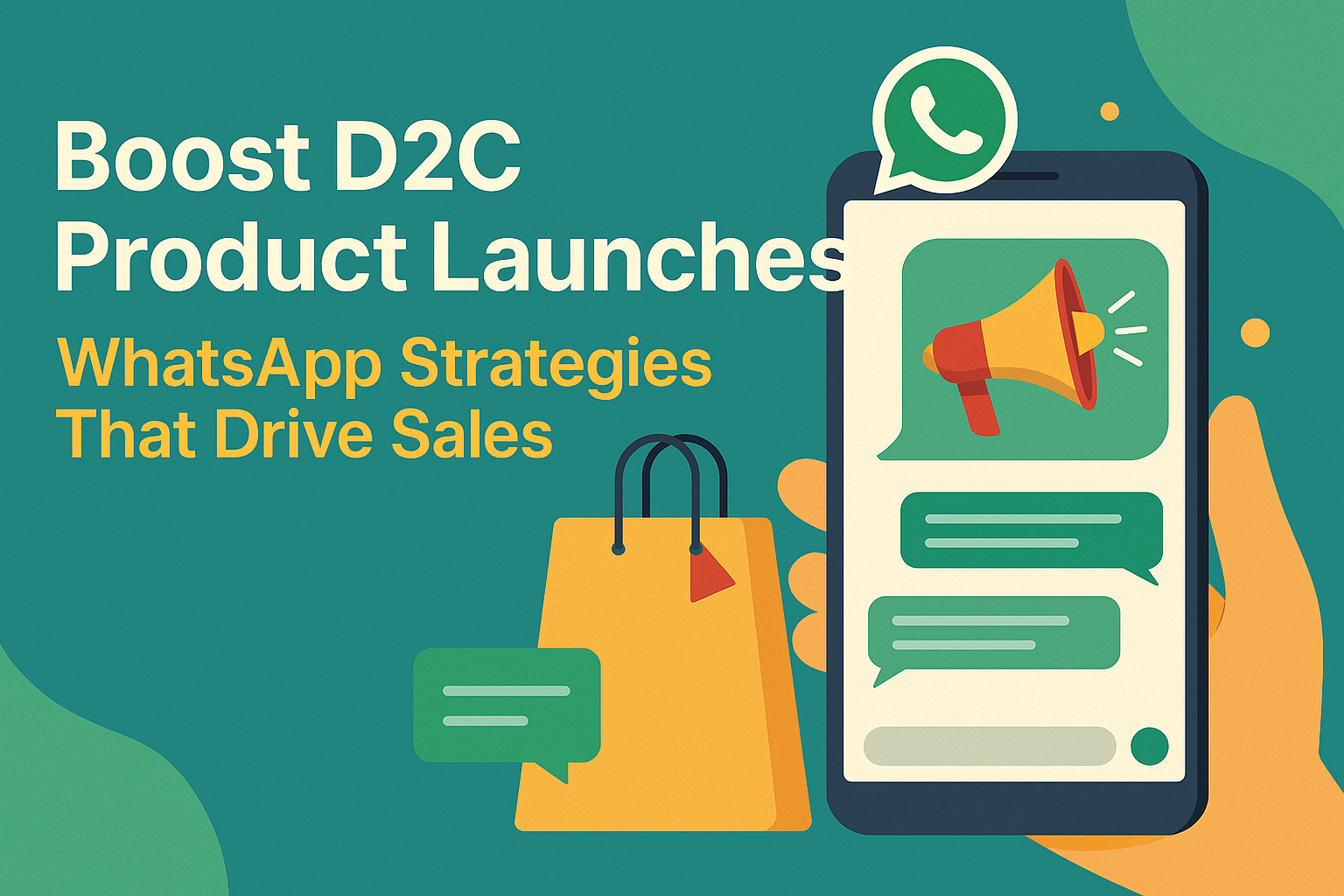
Why WhatsApp Is a Game-Changer for D2C Product Launches In today’s crowded eCommerce space, grabbing consumer attention during a product launch is a challenge. WhatsApp offers D2C brands a direct, personal, and high-engagement channel with open rates reaching 98%, making it a must-have tool for modern product campaigns. With over 500 million users in India alone and mobile-first behavior dominating digital consumption, WhatsApp aligns perfectly with how today’s consumers discover and engage with new products. Planning Your WhatsApp Product Launch Campaign A successful WhatsApp campaign starts with a smart strategy. Here’s how to prepare: Define Your Campaign Goal Be crystal clear about what you want from your campaign. Are you: Each goal shapes your messaging flow. Segment Your Audience Personalization is key. Segment your contact list into: Build Hype with Pre-Launch Messages Start teasing your audience days before launch with: Use WhatsApp’s opt-in flows via website popups, social ads, or QR codes. Leverage Chat Automation Tools Automate welcome messages, reminders, FAQs, and even purchase flows using smart bots and workflows. 👉 Launch Smarter with WhatsApp Automation Message Types That Convert During Launch Not all messages are created equal. Use a mix of high-performing formats: Promotional Templates Highlight: Interactive Messages Use: Voice Notes & Videos Add a personal touch. Use founder voice notes or mini product demos via video. Customer Support Follow-Ups Offer fast responses on delivery, FAQs, and even live order tracking. Real-Time Engagement & Conversational Selling WhatsApp thrives on conversation. During your launch window: It’s a perfect mix of automation + personalization. Post-Launch Retention & Re-Engagement The sale isn’t the end. It’s the start of a relationship. Conclusion D2C product launches are no longer about just a flashy email or a big sale day. WhatsApp allows you to build real-time excitement, offer personal engagement, and create lasting loyalty. With the right strategy and tools, your next launch can skyrocket traffic and conversions. Ready to drive real sales with WhatsApp?👉 Explore Launch Solutions at The Bot Mode FAQs How can WhatsApp help with D2C product launches? WhatsApp helps you build anticipation, send instant launch alerts, engage in real-time, and retarget customers—all on a personal, high-converting channel. What types of messages perform best on WhatsApp? Messages with rich media, quick replies, personalized text, and conversational CTAs tend to perform the best. How do I integrate WhatsApp with my D2C brand platform? You can integrate WhatsApp with your CRM or eCommerce tool using platforms like The Bot Mode for automated flows and audience segmentation.
WhatsApp Cart Recovery Strategies to Reduce Abandonment in 2025
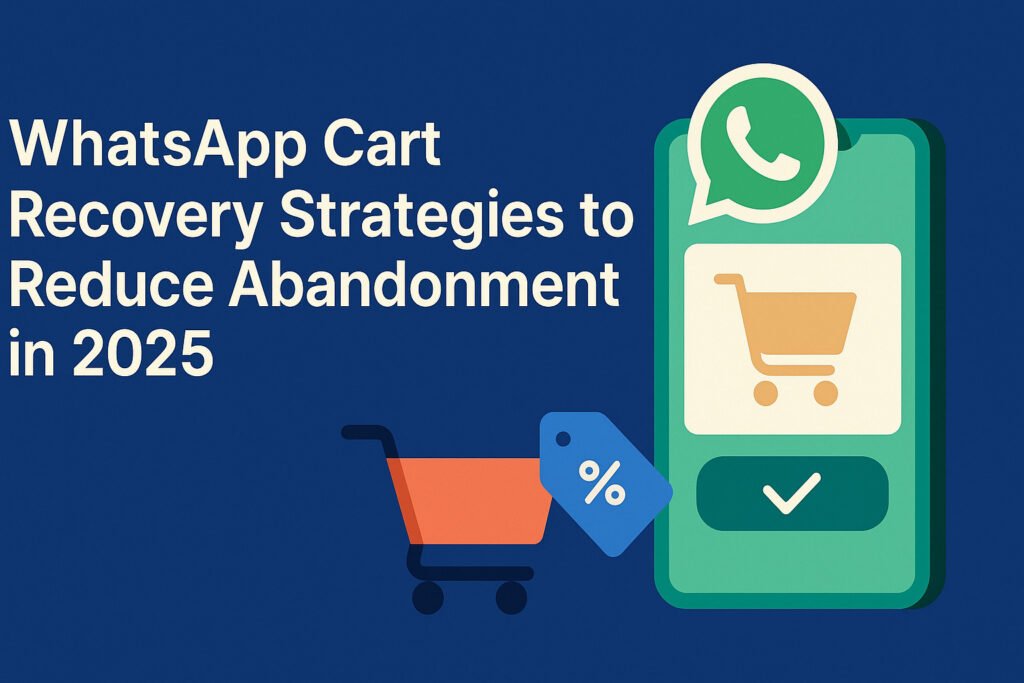
Introduction Abandoned carts are one of the biggest revenue leaks in D2C eCommerce. On average, 7 out of 10 online shoppers leave without completing their purchase. But what if you could re-engage them directly on a platform they actively use every day—WhatsApp? With high open rates and real-time engagement, WhatsApp is emerging as the most effective channel for recovering lost sales. In this blog, we explore the most impactful WhatsApp cart recovery strategies that can help reduce abandonment and boost conversions for your brand in 2025. Why Use WhatsApp for Cart Recovery in D2C eCommerce 1. 98% Open RateWhatsApp messages are opened and read far more frequently than email or SMS. 2. Real-Time EngagementUnlike traditional recovery emails, WhatsApp messages feel more like personal reminders, increasing the likelihood of a response. 3. Higher Conversion RatesFollow-up messages sent via WhatsApp result in 20% to 30% higher recovery rates, outperforming all other communication channels. Top WhatsApp Cart Recovery Strategies 1. Send a Personalized Reminder Within 30 Minutes Timing is critical. Reach out within 30 minutes of abandonment to keep the purchase intent fresh. Use TheBotMode to automate the reminder flow. Message Template Example:Hi [Name], we noticed you left some items in your cart. Complete your order now while they’re still in stock. 2. Offer a Time-Limited Incentive Create urgency by offering a limited-time discount or free shipping to encourage immediate action. Example:Still interested? Enjoy 10% off your cart if you checkout within the next 2 hours. 3. Use Smart Product Reminders with Images Visual reminders help reinforce product recall and increase click-through rates. With TheBotMode, you can send dynamic product messages featuring images, prices, and buttons. Benefits: 4. Build a Multi-Step Recovery Sequence Not all customers convert on the first attempt. Set up a structured 3-step reminder flow: You can automate this entire sequence using TheBotMode’s workflow builder. 5. Collect Feedback from Non-Converters If a customer doesn’t complete the purchase even after reminders, ask for feedback. It may reveal checkout barriers or pricing concerns. Example Message:We noticed you didn’t complete your order. Was there anything we could improve? Use this data to refine your product, messaging, and checkout process. Advanced Strategy: Use Customer Segmentation Not all customers are the same. Segment your users to personalize messages based on: TheBotMode lets you add customer tags and create behavioral segments for precise targeting. Seamless Integration with Shopify & WooCommerce TheBotMode integrates directly with leading eCommerce platforms. It automatically syncs: This allows you to set up personalized cart recovery flows with minimal effort. WhatsApp Cart Recovery in Action One of our D2C fashion clients used TheBotMode’s cart recovery automation and achieved: Conclusion Abandoned carts don’t have to mean lost revenue. With a well-structured WhatsApp cart recovery strategy, D2C brands can re-engage users in real time, increase conversion rates, and improve customer experience. Platforms like TheBotMode make it easy to automate recovery, personalize messaging, and drive results without manual follow-ups. If you’re not using WhatsApp for cart recovery in 2025, you’re leaving revenue on the table. FAQs Q1: What is WhatsApp cart recovery?WhatsApp cart recovery is the practice of sending automated follow-up messages to users who abandoned their carts, encouraging them to complete their purchase. Q2: How effective is WhatsApp for recovering abandoned carts?Brands using WhatsApp for cart recovery typically see up to 30% conversion, outperforming email and SMS. Q3: Can WhatsApp recovery flows be automated?Yes. Platforms like TheBotMode offer full automation for recovery flows based on timing, cart value, and user behavior. Q4: Is WhatsApp cart recovery compliant in India?Yes. As long as users have opted in to receive WhatsApp updates, it is fully legal and compliant with Meta’s policies. Q5: How do I start using TheBotMode for cart recovery?You can integrate TheBotMode with your Shopify or WooCommerce store and activate ready-to-use recovery workflows within minutes. Book a Free Demo with TheBotMode
Best Time to Send WhatsApp Campaigns for Maximum Conversions
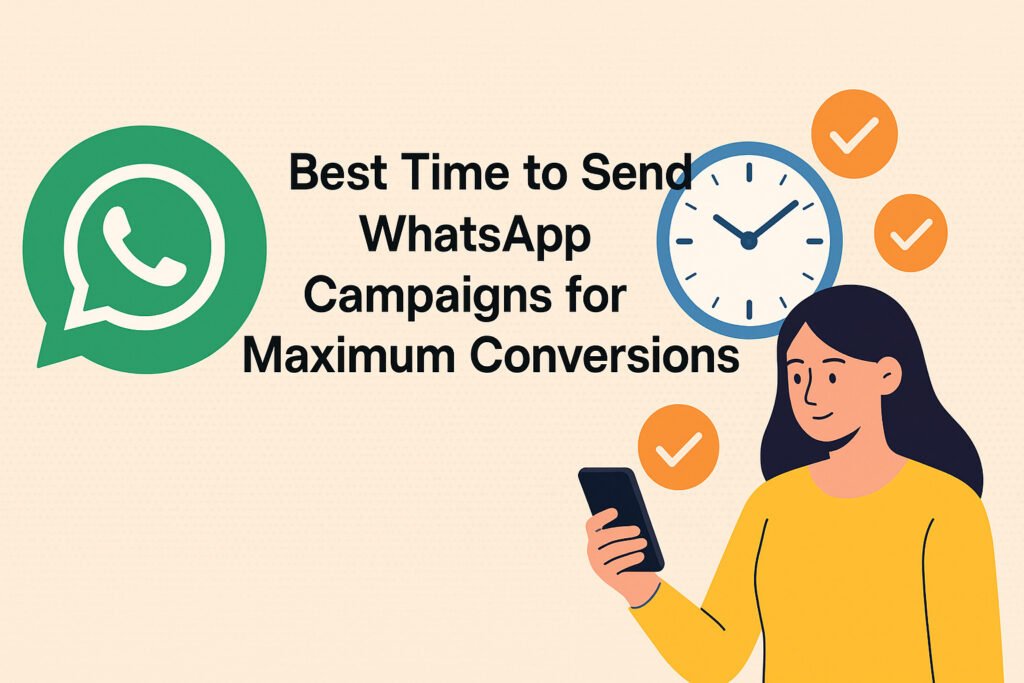
WhatsApp has evolved far beyond a messaging app—it’s now a high-performance marketing channel for D2C brands. But timing your campaigns poorly can undermine even the best offers. So, when is the best time to send WhatsApp campaigns in 2025? Let’s explore the optimal timings, backed by performance data and expert insights from TheBotMode. Why Timing Matters in WhatsApp Marketing WhatsApp marketing campaigns often achieve open rates of over 95%. However, the real metric that matters is conversion. When you send the message plays a critical role in influencing: Based on internal data, optimizing message timing can boost conversions by up to 30%, especially in fast-moving D2C segments like skincare, fashion, and wellness. Best Times to Send WhatsApp Messages in 2025 Morning Window: 9:00 AM – 11:30 AM This is when most users check their phones and engage with offers. It’s ideal for: Afternoon Slot: 1:00 PM – 3:00 PM Post-lunch hours work well for low-pressure content, including: Evening Prime Time: 6:30 PM – 8:00 PM Most D2C shoppers browse at leisure during this window. Perfect for: Times to Avoid Sending WhatsApp Messages How to Improve Open Rates and Conversion Rates 1. Segment Your Audience Use behavioral triggers and purchase history to send contextually relevant messages. 2. Use TheBotMode’s Smart Scheduler Automate WhatsApp messages to be sent at the optimal time for each customer segment. 3. Personalize Every Campaign Use dynamic tags like first names, product preferences, and urgency phrases to increase click-through rates. 4. Test, Learn, Repeat Run A/B tests for different time slots. Measure open rate and conversion performance in TheBotMode’s analytics dashboard. How TheBotMode Helps You Nail Campaign Timing With TheBotMode’s AI-driven automation tools, you can: Case Study: 20% Conversion Boost with Better Timing A D2C skincare brand using TheBotMode made a simple change: they shifted all campaign sends from mid-day to the evening window (6:30–8:00 PM). The results: This shows how strategic timing can directly impact sales performance. Conclusion To succeed with WhatsApp marketing, timing is everything. It’s not just about what your message says—it’s about when it reaches the customer. The right message, sent at the right time, delivers measurable results. Start optimizing your WhatsApp campaign schedule with TheBotMode’s Smart Scheduler and watch your engagement and conversions grow. FAQs Q1. What is the best time to send WhatsApp campaigns for D2C brands? The most effective time windows are 9:00–11:30 AM and 6:30–8:00 PM, based on user engagement trends. Q2. Can I schedule WhatsApp messages in advance? Yes. TheBotMode allows full automation and scheduling based on customer segments and behavior. Q3. How do I know if my campaign timing is effective? Use A/B testing and TheBotMode’s analytics dashboard to compare performance across different time slots.
Why WhatsApp is the New Conversion Engine for Modern D2C Stores
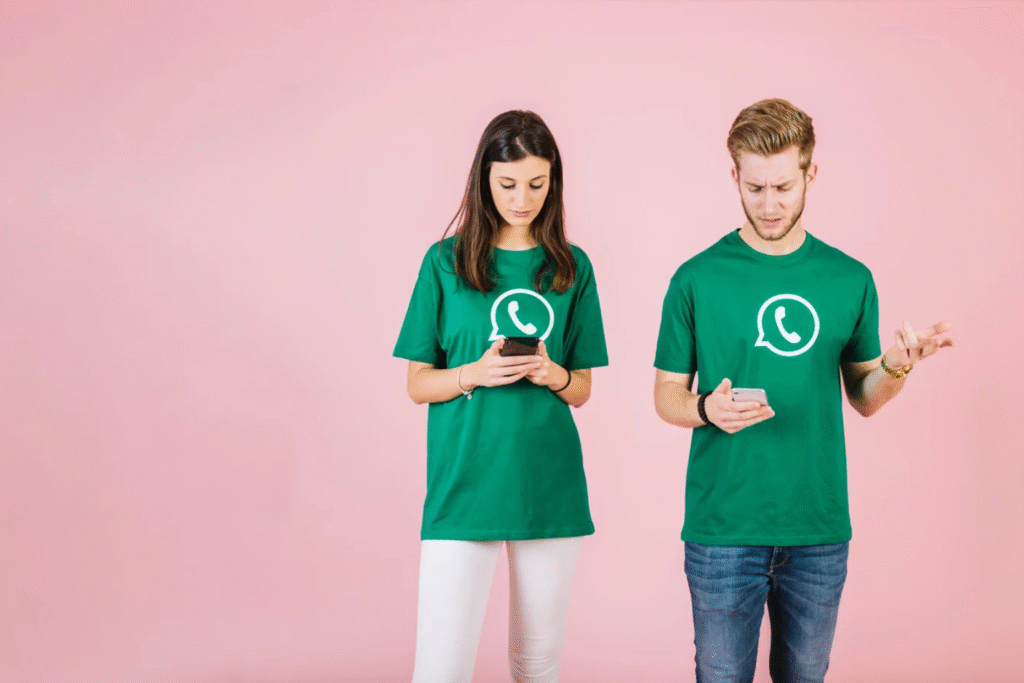
Introduction The D2C (Direct-to-Consumer) industry is evolving rapidly. Consumers want faster responses, more personal interactions, and less friction in their buying journey. Amid these rising expectations, WhatsApp has emerged as the go-to conversion channel for modern eCommerce brands. With open rates close to 98% and click-through rates significantly higher than email or SMS, WhatsApp has quickly become more than just a messaging app. It’s now a complete sales engine—one that D2C brands can’t afford to ignore. Why WhatsApp is Outperforming Traditional Channels 1. Higher Engagement and Response Rates Compared to email and SMS, WhatsApp messages are read almost instantly. This makes it ideal for time-sensitive promotions, order confirmations, and support. 2. Real-Time, Two-Way Communication Whether it’s a pre-sale query or post-purchase support, WhatsApp allows instant, human-like interactions that boost customer confidence and reduce drop-offs. 3. Cart Recovery That Converts Using WhatsApp to remind users about their abandoned carts with direct checkout links and personalized nudges has shown higher conversion rates than traditional retargeting methods. 4. Seamless Order Journey From order confirmation to delivery updates, WhatsApp enables a complete transactional flow. This not only improves user experience but also helps reduce RTOs, especially for COD orders. 5. Smart Automation for Scalability With platforms like TheBotMode, brands can automate product suggestions, repeat purchase reminders, and customer re-engagement based on user behavior—without adding manual workload. The Role of WhatsApp in the Modern D2C Sales Funnel Funnel Stage WhatsApp Contribution Awareness Product highlights, reviews, lead generation flows Consideration FAQs, live chat, testimonials Conversion One-click checkout, offers, abandoned cart recovery Post-Purchase Order tracking, delivery updates, feedback collection Loyalty & Retention Personalized re-engagement, offers, loyalty programs Why TheBotMode is the Ideal WhatsApp Engine for D2C Brands TheBotMode helps D2C brands reduce manual effort while increasing conversions through automated, personalized WhatsApp interactions. FAQs Q1. Why is WhatsApp better than email or SMS for D2C marketing? WhatsApp delivers higher engagement, faster response times, and real-time interactivity, making it ideal for converting interest into purchases. Q2. How can WhatsApp reduce cart abandonment? Automated messages can remind users of abandoned items, offer discounts, and include checkout links to drive quick conversions. Q3. Can small D2C brands benefit from WhatsApp marketing? Yes. Even small brands can use WhatsApp for high-impact communication at low costs, especially with platforms like TheBotMode. Q4. Is it possible to automate WhatsApp conversations? Yes. Tools like TheBotMode offer smart workflows, auto-replies, and personalized campaigns using WhatsApp Business API. Q5. Does WhatsApp help reduce RTO for COD orders? Definitely. By confirming orders and addresses over WhatsApp, brands can reduce failed deliveries and unnecessary logistics costs.
WhatsApp CRM Integration: Manage Customer Data Like a Pro
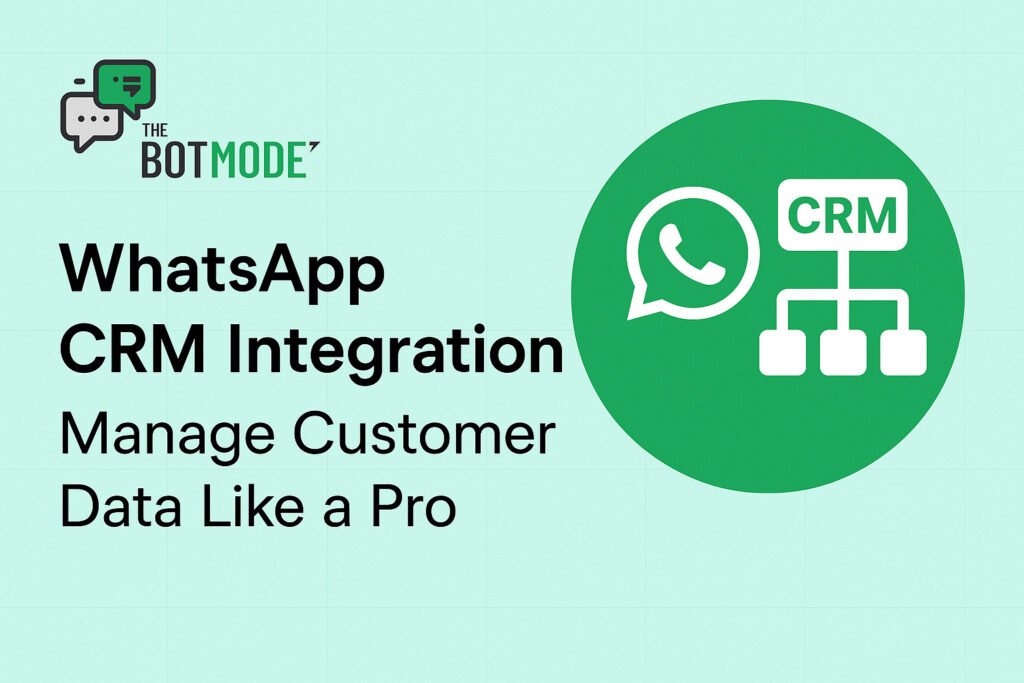
In today’s data-driven D2C world, managing customer information effectively is the secret to building long-term loyalty and increasing revenue. Integrating WhatsApp with your CRM system can revolutionize how you handle leads, conversations, and customer relationships. In this blog, we’ll show you how WhatsApp CRM integration works and why it’s a must-have for D2C brands looking to scale. Why WhatsApp CRM Integration Matters for D2C Brands D2C (Direct-to-Consumer) brands rely heavily on real-time conversations, fast responses, and personalized engagement. WhatsApp is already one of the most popular channels for communicating with customers. But without proper data management, messages can get lost, follow-ups can fail, and conversions can drop. That’s where CRM integration helps. Benefits of WhatsApp CRM Integration: Top CRMs That Work Seamlessly with WhatsApp Many modern CRMs now offer native or third-party WhatsApp integrations. Here are some commonly used ones: With TheBotMode’s automation tools, you can connect WhatsApp to these CRMs using ready-to-deploy APIs and no-code integrations. Use Cases: How D2C Brands Use WhatsApp CRM Integration 1. Lead Capture from WhatsApp Campaigns Run a WhatsApp ad or broadcast, and capture every inbound message directly into your CRM with name, phone number, and chat history. 2. Sales Funnel Automation Set up automated sequences in your CRM that trigger WhatsApp messages—like follow-ups, discount codes, or reminders. 3. Customer Support Tickets Convert WhatsApp chats into tickets in your CRM to assign agents, track resolution times, and improve customer satisfaction. 4. Personalized Product Recommendations Use purchase history and behavior data stored in CRM to send tailored product suggestions via WhatsApp. Step-by-Step: How to Integrate WhatsApp with Your CRM Why TheBotMode is the Best Tool for WhatsApp CRM Integration TheBotMode makes it easy to connect WhatsApp with your CRM—without technical hassles. Our platform offers: Whether you’re using HubSpot or Zoho, TheBotMode ensures your team never misses a lead or customer message. Final Thoughts Managing customer data manually across channels is outdated and inefficient. With WhatsApp CRM integration, you can deliver a smoother, faster, and more personalized customer experience. For D2C brands, it’s not just about messages—it’s about relationships. Start managing your customer data like a pro with TheBotMode’s WhatsApp automation and CRM integration solutions. FAQs: Q1. What is WhatsApp CRM integration? WhatsApp CRM integration is the process of connecting WhatsApp Business API with your CRM system to manage customer conversations, data, and workflows from one place. Q2. Can small D2C brands use WhatsApp CRM integration? Yes! With no-code tools like TheBotMode, even small D2C brands can automate and streamline their WhatsApp conversations. Q3. Is WhatsApp integration secure? Absolutely. WhatsApp Business API ensures end-to-end encryption and data privacy when connected to verified CRMs. Q4. How much does WhatsApp CRM integration cost? It depends on your CRM and WhatsApp API provider. TheBotMode offers affordable plans for startups and growing D2C brands. Q5. Can I track customer history in CRM from WhatsApp chats? Yes, with integration, all chat histories and customer interactions are logged in your CRM.
WhatsApp Drip Campaigns: A Game-Changer for D2C Marketing Strategies
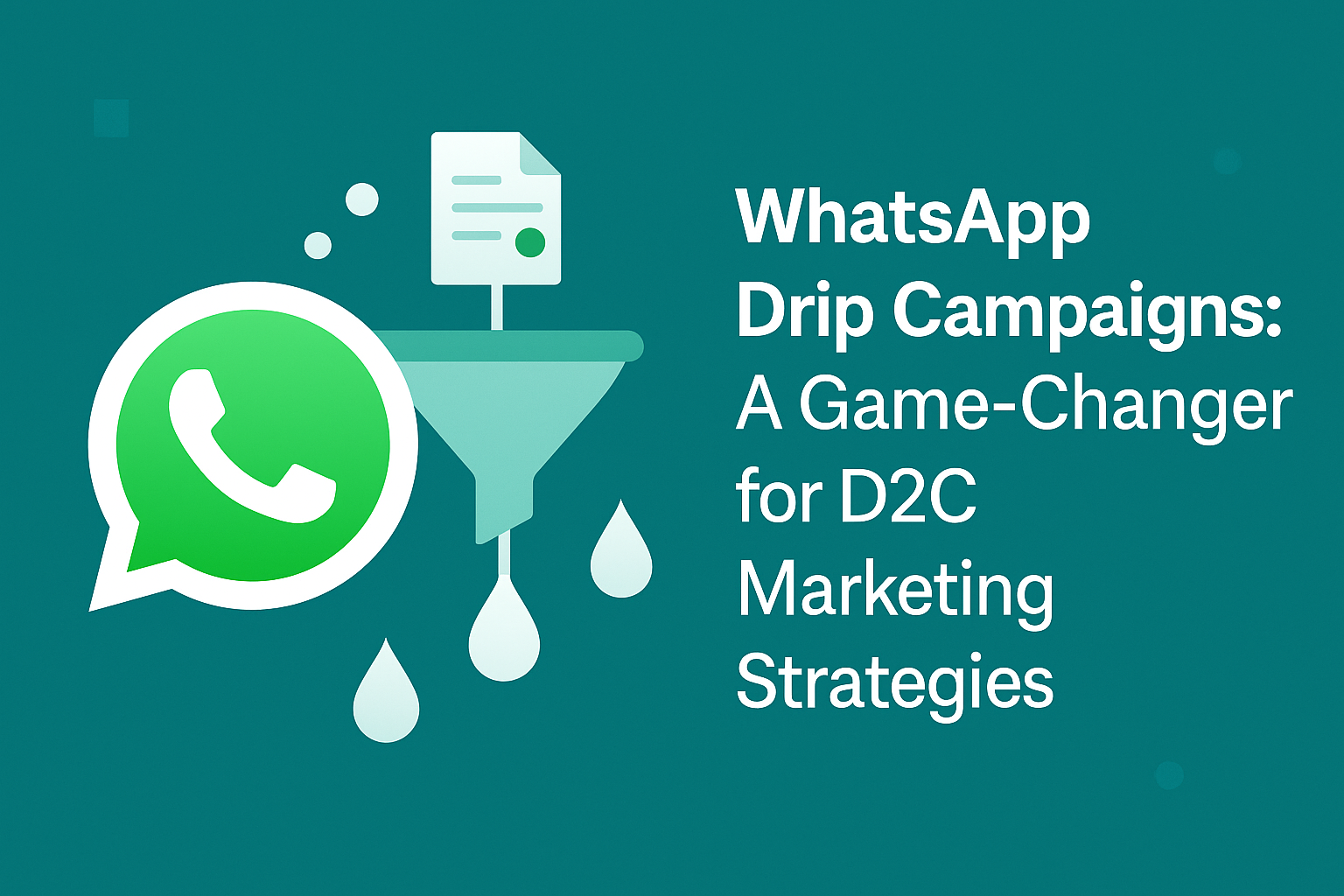
Introduction In the competitive landscape of Direct-to-Consumer (D2C) brands, capturing and retaining customer attention is paramount. Traditional marketing channels often fall short in delivering personalized and timely messages. Enter WhatsApp drip campaigns—a dynamic tool that enables brands to engage customers through automated, personalized messaging sequences. Understanding WhatsApp Drip Campaigns What is a WhatsApp Drip Campaign? A WhatsApp drip campaign is a series of automated messages sent to customers over time, triggered by specific actions or timelines. These campaigns aim to nurture leads, onboard new users, or re-engage existing customers with personalized content. Benefits Over Traditional Channels Why WhatsApp is Essential for D2C Brands Vast User Base With over 2 billion active users globally, WhatsApp provides an unparalleled platform for reaching diverse demographics. In markets like India, WhatsApp has become an integral part of daily communication. Enhanced Customer Engagement WhatsApp enables two-way communication, allowing brands to interact with customers in a more personal and conversational manner. This fosters trust and loyalty, essential components for D2C success. Setting Up a WhatsApp Drip Campaign Step 1: Define Campaign Goals Identify the objective of your campaign—be it onboarding, re-engagement, or upselling. Clear goals will guide the content and structure of your messages. Step 2: Segment Your Audience Divide your customer base into segments based on behavior, purchase history, or demographics. This ensures that messages are relevant and personalized. Step 3: Craft Personalized Messages Develop message sequences that resonate with each segment. Incorporate customer names, past interactions, and tailored offers to enhance engagement. Step 4: Utilize Automation Tools Leverage WhatsApp Business API and automation platforms to schedule and send messages efficiently. Tools like The BotMode can streamline this process. Step 5: Monitor and Optimize Track key performance indicators (KPIs) such as open rates, click-through rates, and conversions. Use this data to refine your campaign for better results. Best Practices for Effective WhatsApp Drip Campaigns Obtain Explicit Consent Ensure compliance with data protection regulations by obtaining clear consent from users before sending messages. Personalize Content Use customer data to tailor messages, making them more relevant and engaging. Optimize Timing and Frequency Schedule messages at times when customers are most likely to engage, and avoid overwhelming them with too many messages. Incorporate Rich Media Enhance messages with images, videos, or interactive elements to capture attention and convey information effectively. Test and Iterate Conduct A/B testing to determine what content and timing work best, and continuously refine your strategy based on results. Measuring Success and ROI Key Metrics to Track Tools for Analysis Utilize analytics tools compatible with WhatsApp Business API to gather insights and inform future campaigns. Conclusion WhatsApp drip campaigns offer D2C brands a powerful avenue for personalized, timely, and effective customer engagement. By leveraging automation, segmentation, and data-driven strategies, brands can enhance customer experiences and drive conversions. Ready to revolutionize your D2C marketing strategy? Explore how The BotMode can help you implement successful WhatsApp drip campaigns today. FAQs Q1: What is a WhatsApp drip campaign? A WhatsApp drip campaign is a series of automated messages sent to customers over time, based on specific triggers or schedules, aimed at nurturing leads or engaging customers. Q2: How can D2C brands benefit from WhatsApp drip campaigns? They enable personalized communication, higher engagement rates, and improved customer retention, leading to increased sales and brand loyalty. Q3: What tools are needed to set up a WhatsApp drip campaign? You’ll need access to the WhatsApp Business API and an automation platform like The BotMode to manage and schedule messages. Q4: Are there compliance considerations for WhatsApp marketing? Yes, it’s essential to obtain explicit consent from users and adhere to data protection laws and WhatsApp’s business policies. Q5: How do I measure the success of my WhatsApp drip campaigns? Track metrics such as open rates, click-through rates, conversion rates, and customer retention to evaluate performance and make informed improvements.
Top 10 WhatsApp Broadcast Ideas That Drive Sales for D2C Businesses
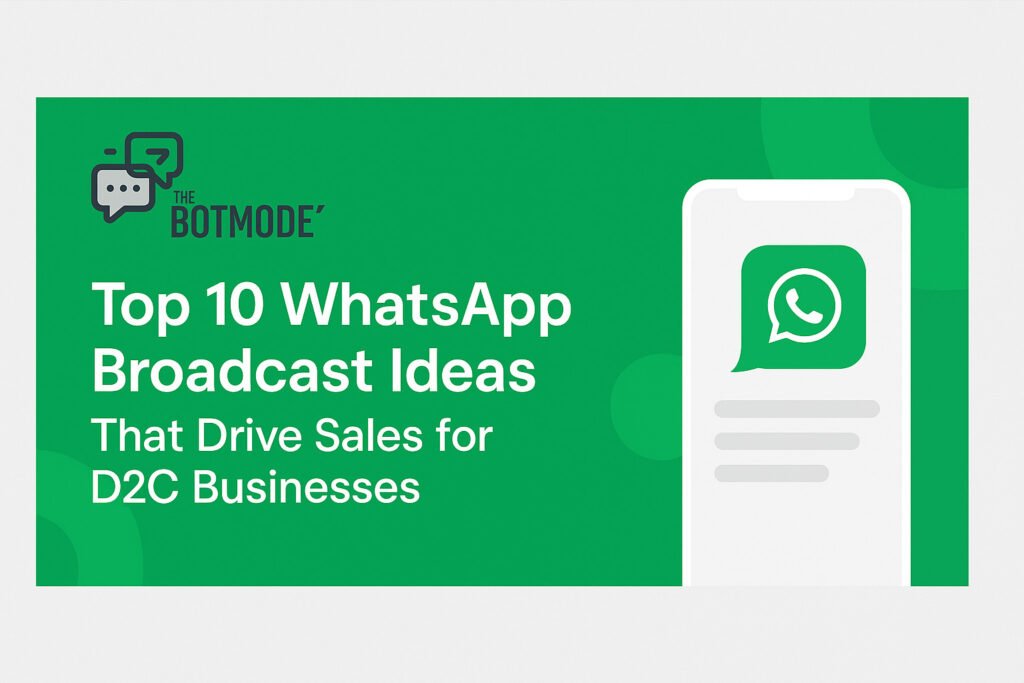
Why WhatsApp Broadcasts Matter for D2C Brands In the fast-paced world of D2C marketing, WhatsApp has evolved into a high-conversion sales channel. With an open rate exceeding 90%, strategic WhatsApp broadcasts can significantly enhance customer engagement and boost revenue. At TheBotMode, we enable D2C brands to automate and scale their WhatsApp marketing using the official WhatsApp Business API. Below are 10 high-performing WhatsApp broadcast ideas designed to help you increase sales in 2025. 1. New Product Launch Announcements Generate anticipation and drive immediate traffic with sneak peeks and early access links. Use rich media like images or short videos to showcase new products. Example Message: Just launched: Our new summer collection is now live. Limited stock available. Shop now: [Link] Why it works: Early announcements create a sense of exclusivity, prompting quicker decisions and driving impulse purchases. 2. Limited-Time Offers and Flash Sales Create urgency with time-sensitive deals. Clearly mention the discount and the time limit to drive immediate action. Example Message: Flash Sale: Get 30% off for the next 6 hours. Don’t miss it: [Link] Pro Tip: Use TheBotMode’s scheduling feature to send these messages during your brand’s peak engagement hours. 3. Back-in-Stock Alerts Notify customers when previously sold-out products are available again. This is highly effective for interested or waitlisted buyers. Example Message: Back in stock: Our best-selling oversized tee is available again. Order now before it sells out: [Link] Why it converts: It targets high-intent users who have shown interest earlier. 4. Exclusive Discounts for VIP Customers Build loyalty by offering special deals to your top customers. It can also include early access to sales or limited-edition products. Example Message: Thank you for being a valued customer. Enjoy 20% off sitewide with code VIP20. Shop here: [Link] Why it works: Recognizing and rewarding loyalty increases customer retention and lifetime value. 5. Abandoned Cart Reminders Recover lost sales with automated reminders that include images, product names, and links. Example Message: You left something in your cart. Complete your order before it’s gone: [Link] Boost It: Include a time-limited discount code to increase urgency. 6. Festival and Seasonal Greetings with Offers Use festivals and seasons as natural sales opportunities. Tie them to exclusive offers or limited collections. Example Message: Happy Diwali. Celebrate with 25% off on festive collections. Offer valid today only: [Link] Why it’s smart: Customers are more willing to shop during festive periods and holidays. 7. Customer Reviews and Social Proof Leverage positive customer reviews or user-generated content (UGC) to build trust. Example Message: Here’s what our customer Sneha said about our embroidered kurtis: “Absolutely stunning. I received so many compliments.” Check it out: [Link] Why it works: Real reviews reduce buying hesitation and increase confidence. 8. Weekly Product Highlights Feature trending products, bestsellers, or editor’s picks to keep users engaged weekly. Example Message: Top Picks This Week: Oversized T-shirts, Cotton Kurtis, and more. Explore now: [Link] Bonus: Use carousel images to increase visual interest. 9. Order Updates with Upsell Opportunities Send transactional updates like order confirmation and delivery alerts, paired with smart cross-sell suggestions. Example Message: Your order has been shipped. Meanwhile, check out these accessories that pair well with your purchase: [Link] Why it works: Customers are highly engaged after placing an order and are more likely to respond to related product recommendations. 10. Polls and Feedback Requests Engage your audience while collecting insights. Offer a small incentive for completing surveys or polls. Example Message: Help us improve by taking a short 1-minute survey. Receive 10% off your next purchase. Start here: [Link] Why it works: Encourages interaction while gathering valuable feedback to improve your offerings. Final Thoughts WhatsApp broadcasting is one of the most underutilized yet powerful marketing tools for D2C brands. When done right—with personalization, timing, and value—it drives conversions and builds lasting customer relationships. At TheBotMode, we simplify WhatsApp marketing using the official Business API. Whether you’re launching a collection, recovering carts, or re-engaging dormant users, our platform helps you drive real results through smart automation and insights. FAQs Q1. What is a WhatsApp broadcast? A WhatsApp broadcast allows you to send a message to multiple users simultaneously without creating a group. Only users who have saved your number will receive the message. Q2. Is WhatsApp broadcast free to use? Yes, if you use the WhatsApp Business App. However, the WhatsApp Business API (which supports large-scale or automated sending) may have associated messaging costs. Q3. Can I personalize WhatsApp broadcasts? Yes. With TheBotMode’s WhatsApp API integration, you can personalize messages using customer names, cart contents, and more. Q4. How many users can I broadcast to on WhatsApp? The WhatsApp Business App allows up to 256 contacts per broadcast. With the API, you can send broadcasts to an unlimited number of users based on your plan. Q5. How do I track the performance of WhatsApp broadcasts? Track metrics such as open rate, click-through rate, responses, and conversions. TheBotMode provides real-time analytics to help optimize your campaigns. Book a Free Demo with TheBotMode













